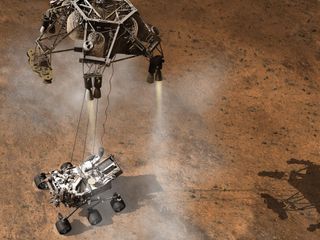Huge Mars Rover One Month from Red Planet Landing

The biggest rover ever launched to another planet is just one month away from its target: the Red Planet, Mars.
NASA's huge Curiosity rover is hurtling toward a planned late-night landing on Mars on Aug. 5 PDT (early Aug. 6 EDT), and the anticipation on the science team is high. The reasons are clear: At 1 ton, Curiosity is the largest rover ever aimed at Mars. It will land in a completely new way, using a giant parachute and a rocket-powered sky crane. And it is carrying a sophisticated set of tools to find out if its Martian drop zone could once have been home for life.
But that's all in the future. First Curiosity has to reach Mars in one piece.
![This artist’s concept depicts the NASA Mars Science Laboratory Curiosity rover, a nuclear-powered mobile robot for investigating the Red Planet’s past or present ability to sustain microbial life. [Related Photos: The Search for Life on Mars]](https://cdn.mos.cms.futurecdn.net/dgiiedJ62PohrMFYa6EukB-320-80.jpg)
"I think people are kind of waiting," Richard Cook, the rover's deputy project manager, told SPACE.com. "It's a little bit like waiting for a final. You're patiently counting down the days."
NASA launched the $2.5 billion rover in November 2011 in a bid to explore Mars as never before. NASA's Jet Propulsion Laboratory in Pasadena, Calif., is overseeing the mission.
Curiosity is a six-wheeled robot the size of a Mini Cooper car. As the centerpiece of NASA's Mars Science Laboratory mission, it has a nuclear power source to keep it running for a full Martian year (about 23 Earth months) and 10 primary science instruments to study the Red Planet's surface, atmosphere and past habitability.
"It's just more complicated in kind of every way" than past Mars landers, Cook says. That includes the rover Opportunity, which is still active on the Red Planet. [Mars Science Laboratory Curiosity: Complete Coverage]
Get the Space.com Newsletter
Breaking space news, the latest updates on rocket launches, skywatching events and more!
Nail-biting landing plan
Curiosity will drop into the huge Gale crater, a 96-mile wide (154-kilometer) indentation with a central mountain rising 3 miles (5 km) into the Martian sky.
If all goes well, the rover's entry capsule will plunge into the Martian atmosphere at 13,200 mph (21,243 kph), with a heat shield protecting it from the searing temperatures of entry. At 7 miles up (11 km), it will unfurl the largest parachute ever sent to another world (about 51 feet wide, or 16 meters) to start slowing down.
Then the descent stage should kick in, firing eight rocket engines to slow the spacecraft down even more. At a height of 66 feet (20 meters), the sky crane maneuver will lower Curiosity on cables.
Only then, 12 seconds before touchdown, will the rover's wheels pop into place so it can be lowered the rest of the way to the Gale crater floor. Once sensors show Curiosity is firmly on Mars, the rocket sky crane will sever its connecting cables and fly off to crash a safe distance away.
The entire landing procedure is to take seven minutes. NASA calls it "seven minutes of terror."
Cook said Curiosity has been tested time and time again to make sure everything is as ready as it can be for landing. The team, he said, is "cautiously optimistic" of a smooth touchdown.
Final approach to Mars
That's not to say NASA's Mars Science Laboratory team can only sit and hope for success. Mission planners have been steadily preparing for Curiosity's novel landing and its first days on Mars.[Mars Rover Curiosity: 11 Amazing Facts]
Last week, mission managers ordered Curiosity's cruise stage to fire its thrusters in a maneuver designed to fine-tune the rover's approach to Gale crater. The maneuver shifts Curiosity's entry point into the Mars atmosphere by 125 miles (200 km) and has moved the scheduled entry up by 70 seconds.

"This puts us closer to our entry target, so if any further maneuvers are needed, I expect them to be small," said Tomas Martin-Mur, Curiosity's navigation team chief at JPL, in a June 26 statement.
Next week Curiosity's landing mission team will assemble at JPL for a weeklong simulation of the approach and landing. The simulation will last four days: the two days leading up to the mock Mars touchdown (which is set for late Thursday night) and the two that follow.
"It is our big dress rehearsal," Cook said. Most of the landing sequence for Curiosity is ultimately automated, so "the thing that we're really testing here is really the people."
You can follow SPACE.com Managing Editor Tariq Malik on Twitter @tariqjmalik. Follow SPACE.com on Twitter @Spacedotcom. We're also on Facebook and Google+.
Join our Space Forums to keep talking space on the latest missions, night sky and more! And if you have a news tip, correction or comment, let us know at: community@space.com.

Tariq is the Editor-in-Chief of Space.com and joined the team in 2001, first as an intern and staff writer, and later as an editor. He covers human spaceflight, exploration and space science, as well as skywatching and entertainment. He became Space.com's Managing Editor in 2009 and Editor-in-Chief in 2019. Before joining Space.com, Tariq was a staff reporter for The Los Angeles Times covering education and city beats in La Habra, Fullerton and Huntington Beach. In October 2022, Tariq received the Harry Kolcum Award for excellence in space reporting from the National Space Club Florida Committee. He is also an Eagle Scout (yes, he has the Space Exploration merit badge) and went to Space Camp four times as a kid and a fifth time as an adult. He has journalism degrees from the University of Southern California and New York University. You can find Tariq at Space.com and as the co-host to the This Week In Space podcast with space historian Rod Pyle on the TWiT network. To see his latest project, you can follow Tariq on Twitter @tariqjmalik.
Most Popular


